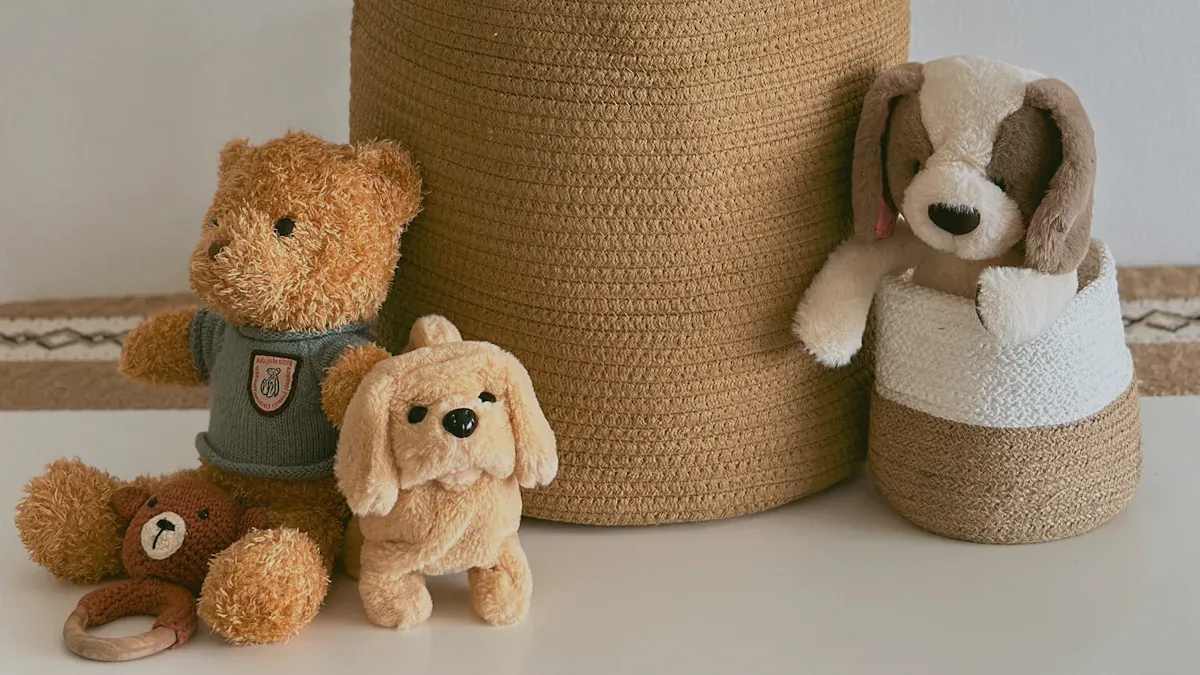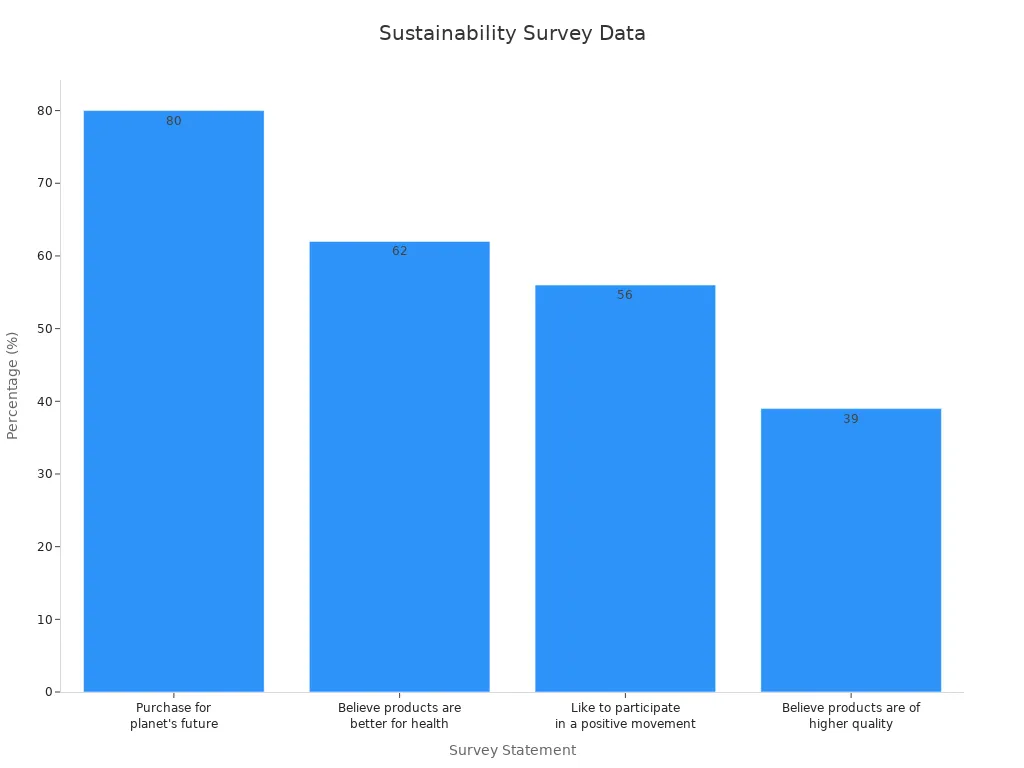
The global demand for Eco-Friendly Dog Toys has significantly increased, fueled by evolving consumer values and purchasing habits. More than half of pet owners now show a readiness to invest in sustainable pet care products. This growing trend highlights a strong connection between consumer behavior and environmental responsibility. Wholesale Buyers in 2025 are expected to actively respond to this demand, with products labeled as “certified human raised and handled” already seeing a remarkable 110% sales growth, reaching $11 million. By aligning with this movement, businesses can unlock a lucrative market while building trust and loyalty among eco-conscious customers.
Key Takeaways
- Green dog toys are popular because people care more about the planet.
- The eco-friendly pet toy market may grow to $3.1 billion by 2035.
- Pet owners want safe toys, choosing non-toxic ones over regular toys.
- Strong toys are important; they last longer and make less trash.
- Companies using recycled rubber or organic cotton attract green-minded buyers.
- Labels like the Recycled Claim Standard help prove products are eco-friendly.
- Stores should sell more green toys to match what shoppers want.
- Working with eco-friendly brands helps businesses stay popular and sell more.
Why Eco-Friendly Dog Toys Are the #1 Demand in 2025
Consumer Preferences for Sustainability
The growing demand for eco-friendly dog toys stems from a significant shift in consumer values. Pet owners increasingly prioritize sustainability when making purchasing decisions. A recent market analysis revealed that the eco-friendly pet toys market is expected to grow from USD 1.65 billion in 2024 to USD 3.1 billion by 2035, with a compound annual growth rate (CAGR) of 5.9%. This growth reflects the rising interest in sustainable products, particularly among dog owners seeking durable and biodegradable options.
Consumers are also motivated by the desire to contribute to environmental conservation. A survey found that 80% of pet owners purchase eco-friendly products to secure a better future for the planet. Additionally, 62% believe these products are healthier for their pets, while 56% enjoy participating in a positive movement. These preferences highlight the strong connection between sustainability and consumer behavior, making eco-friendly dog toys a top priority for wholesale buyers in 2025.

Environmental Awareness and Responsibility
Environmental concerns play a pivotal role in driving the demand for eco-friendly dog toys. Traditional pet products contribute to approximately 300 million pounds of plastic waste annually in North America alone. This alarming statistic has heightened awareness among pet owners, prompting them to seek sustainable alternatives. Many consumers now prefer toys made from recycled or biodegradable materials, reducing their environmental footprint.
Government regulations on single-use plastics and waste management further encourage the adoption of eco-friendly products. Initiatives like the Pet Sustainability Coalition’s Packaging Pledge have also inspired companies to embrace sustainable practices. Wholesale buyers are responding to these trends by expanding their eco-friendly product lines, ensuring they meet the expectations of environmentally conscious consumers.
Health and Safety Concerns for Pets
Health and safety concerns are another critical factor influencing the popularity of eco-friendly dog toys. Many traditional toys contain harmful chemicals that can pose risks to pets. A study revealed that 75% of pet owners worry about the presence of chemicals in conventional toys, while 70% prefer eco-friendly options.
Eco-friendly dog toys are often made from non-toxic, natural materials, ensuring they are safe for pets to chew and play with. These products also align with the growing demand for high-quality, durable toys that promote mental stimulation and physical activity. Dogs represent the largest segment in the eco-friendly pet toys market, with interactive and chew toys experiencing the fastest growth. Wholesale buyers in 2025 are expected to prioritize these products to meet the needs of health-conscious pet owners.
Features That Define Eco-Friendly Dog Toys

Use of Sustainable and Recycled Materials
Eco-friendly dog toys stand out due to their use of sustainable and recycled materials. Brands increasingly employ advanced recycling technologies to create toys that minimize environmental impact while reducing production costs. These toys often feature materials like recycled rubber, hemp, and organic cotton, which are biodegradable and toxin-free.
Pet owners favor products crafted from recycled polyester or all-natural cotton grown without harmful pesticides. Additionally, toys made sustainably without toxic glues or PVCs align with consumer preferences for safer options. This shift reflects a broader trend where pet owners actively seek biodegradable toys and other eco-friendly pet care products, such as organic food and grooming items.
By prioritizing sustainable materials, manufacturers not only reduce their carbon footprint but also meet the growing demand for environmentally responsible products. This approach ensures that eco-friendly dog toys remain a top choice for wholesale buyers in 2025.
Durability and Long-Lasting Design
Durability is a critical feature of eco-friendly dog toys, as it ensures long-term use and reduces waste. Many brands focus on creating toys that withstand wear and tear, providing value to both pets and their owners. For instance, West Paw’s eco-friendly toys, made from Zogoflex material, have a return rate of less than 1%, highlighting their exceptional durability. Customers often opt for replacements rather than refunds, demonstrating high satisfaction with these long-lasting products.
TechGearLab’s durability testing further supports this trend. Their analysis, which accounts for 30% of a toy’s overall score, involves real-world testing with various dogs. This rigorous evaluation helps identify toys that can endure tough play while maintaining their functionality.
By investing in durable designs, manufacturers contribute to sustainability by reducing the frequency of replacements. Wholesale buyers recognize this value and prioritize durable eco-friendly dog toys to meet consumer expectations.
Ethical and Transparent Manufacturing Practices
Ethical and transparent manufacturing practices are essential for eco-friendly dog toys. Certifications such as WRAP, WFTO, and SA8000 validate a company’s commitment to fair trade, ethical labor, and social accountability. These certifications enhance a brand’s reputation and attract eco-conscious consumers.
For example, the Recycled Claim Standard verifies the presence of recycled materials in products, promoting sustainability in textiles. Similarly, the Better Cotton Initiative supports sustainable cotton production while improving the livelihoods of farmers. Companies adhering to these standards demonstrate their dedication to ethical practices, ensuring that their products align with consumer values.
Wholesale buyers increasingly seek partnerships with brands that uphold these principles. By leveraging certifications and transparent practices, they build trust with consumers and strengthen their position in the eco-friendly market.
How Wholesale Buyers Are Adapting to the Eco-Friendly Trend
Partnering with Sustainable Brands
Wholesale buyers are increasingly forming partnerships with sustainable brands to meet the growing demand for eco-friendly products. These collaborations allow buyers to align their offerings with consumer expectations for environmentally responsible goods. Sustainable sourcing practices, which integrate social, ethical, and environmental performance factors into supplier selection, have become a cornerstone of these partnerships.
The Retail Sourcing and Procurement Market has experienced significant growth due to heightened consumer awareness of environmental impacts. Retailers now prioritize sourcing from environmentally friendly suppliers, ensuring their product lines reflect a commitment to sustainability. A 2024 McKinsey & Company survey revealed that 75% of millennials and 66% of all respondents consider sustainability when making purchase decisions. This generational shift underscores the importance of partnering with brands that share similar values, enabling wholesale buyers to remain competitive in the evolving market.
Expanding Eco-Friendly Product Lines
Wholesale buyers are actively expanding their eco-friendly product lines to cater to the increasing demand for sustainable options. This strategic move not only addresses consumer preferences but also positions businesses as leaders in the eco-conscious market. Executives are integrating sustainability into their core business strategies, fostering innovation and engaging stakeholders in meaningful ways.
Market evidence highlights the financial and environmental benefits of adopting sustainable practices. For instance, 70% of B2B buyers in Europe are willing to pay a premium for sustainable products, demonstrating a strong market demand. Additionally, the Business of Sustainability Index shows a growing interest in eco-friendly products among younger demographics and parents. By diversifying their offerings to include items like biodegradable dog toys and products made from recycled materials, wholesale buyers can attract a broader customer base while reinforcing their commitment to sustainability.
Leveraging Certifications to Build Consumer Trust
Certifications play a crucial role in building consumer trust in eco-friendly products. Green certifications, such as the Recycled Claim Standard and the Better Cotton Initiative, validate a brand’s commitment to sustainability and ethical practices. These certifications enhance a company’s reputation and encourage consumers to choose their products over competitors.
Research indicates that certifications increase consumers’ willingness to pay for eco-friendly products by associating them with environmentally responsible brands. However, concerns about greenwashing highlight the need for transparency and accountability in certification processes. Wholesale buyers can leverage certifications to demonstrate their dedication to sustainability while addressing potential skepticism. By partnering with certified brands and promoting their eco-friendly credentials, buyers can strengthen consumer trust and loyalty.
Wholesale buyers in 2025 are adapting to these trends by prioritizing partnerships with sustainable brands, expanding their eco-friendly product lines, and leveraging certifications. These strategies ensure they remain competitive in the growing market for Eco-Friendly Dog Toys: Wholesale Buyers in 2025 while meeting the expectations of environmentally conscious consumers.
Examples of Leading Eco-Friendly Dog Toy Brands

Brand A: Innovating with Sustainable Materials
Brand A has emerged as a leader in the eco-friendly pet toy market by prioritizing innovation and sustainability. This brand utilizes advanced recycling technologies to create toys from materials like recycled plastics, organic cotton, and hemp. These efforts align with global sustainability goals, ensuring minimal environmental impact throughout the product lifecycle.
| Metric | Description |
|---|---|
| Sustainability Index Score | Evaluates economic, environmental, and social performance compared to industry standards. |
| Global Reporting Initiative (GRI) Standards | Measures and communicates environmental and social impacts through standardized reporting. |
| UN Sustainable Development Goals (SDGs) Alignment | Aligns company objectives with global sustainability targets. |
| Certifications and Ratings | Demonstrates commitment to sustainability through industry-specific certifications. |
| Lifecycle Assessment (LCA) | Assesses environmental impact across the product lifecycle. |
| Innovation KPIs | Tracks revenue from sustainable products and the development of eco-friendly innovations. |
These metrics highlight Brand A’s dedication to creating environmentally responsible products. By aligning with initiatives like the UN Sustainable Development Goals, the brand ensures its toys meet the highest standards of sustainability. This commitment resonates with the 66% of global consumers willing to pay more for sustainable brands, as reported by Nielsen.
Brand B: Ethical Production and Fair Labor Practices
Brand B sets itself apart by emphasizing ethical production and fair labor practices. The company ensures that all factories comply with rigorous social compliance audits, which assess health, safety, and employee treatment. These audits include unannounced visits and mandatory follow-ups to address any issues.
| Evidence Type | Description |
|---|---|
| Ethical Sourcing | Implements principles for factories, ensuring compliance with global business ethics standards. |
| Social Compliance Audits | Conducts unannounced audits to evaluate working conditions, pay, and safety, with immediate remediation for critical issues. |
This transparent approach to manufacturing builds trust among eco-conscious consumers. A growing number of pet owners—70%, according to recent studies—prefer brands that demonstrate environmental and social responsibility. Brand B’s commitment to ethical sourcing not only supports fair labor but also enhances its reputation as a socially responsible leader in the pet toy industry.
Brand C: Combining Durability with Environmental Responsibility
Brand C excels in creating durable, eco-friendly dog toys that meet the needs of both pets and their owners. The brand uses innovative biodegradable materials that withstand vigorous play while reducing environmental impact. Testimonials from satisfied customers frequently highlight the toys’ ability to endure tough use without compromising on sustainability.
- Approximately 65% of pet owners consider durability essential when purchasing biodegradable toys, showcasing the importance of long-lasting designs.
- Education about technological advancements in eco-friendly materials fosters consumer trust, encouraging adoption of sustainable products.
- Brands like West Paw, which diverts over 99% of production waste from landfills, demonstrate how durability and environmental responsibility can coexist.
By focusing on durability, Brand C addresses a key concern for pet owners while contributing to waste reduction. This dual focus ensures the brand remains a top choice for wholesale buyers seeking reliable and sustainable products.
The Future of Eco-Friendly Dog Toys in the Global Market
Market Growth and Consumer Trends Beyond 2025
The eco-friendly dog toy market is poised for remarkable growth beyond 2025. Projections indicate a significant increase in market size, driven by rising consumer awareness and demand for sustainable products. According to market data:
| Year | Market Size (USD) | CAGR (%) |
|---|---|---|
| 2025 | 4.4 billion | - |
| 2035 | 8.6 billion | 7.9 |
This growth trajectory underscores the increasing importance of sustainability in the pet industry. Millennials and Gen Z consumers, who prioritize environmental responsibility, are expected to play a pivotal role in shaping market trends. A recent analysis revealed that 81% of these demographics support sustainable business actions, while 9.7% are willing to pay a premium for sustainably produced items. These statistics highlight a shift in purchasing behavior, with younger generations driving demand for eco-conscious products.
Additionally, the market is likely to see diversification in product offerings. Innovations in materials, such as biodegradable composites and recycled textiles, will cater to evolving consumer preferences. Interactive and multifunctional toys that combine durability with environmental benefits are expected to dominate the market. Wholesale buyers and manufacturers must adapt to these trends to remain competitive and capture the growing eco-friendly segment.
Opportunities for Businesses to Lead in Sustainability
Businesses have a unique opportunity to establish themselves as leaders in sustainability within the pet product industry. Strategic market reports emphasize the importance of aligning with consumer values and leveraging innovation to gain a competitive edge. Key insights from industry analyses include:
| Report Title | Key Insights |
|---|---|
| Harnessing Marketing & PR Expertise for Success in the Pet Industry | Access to timely reports and consumer trends that highlight sustainability and innovation in pet products. |
| The Full View of The Pet Industry | Identifies Gen Z as a key demographic for sustainable pet products, emphasizing online shopping and niche categories. |
| The Growing Financial Implications of the Pet Industry | Highlights investment trends towards organic, sustainable products and tech-enabled solutions in the pet industry. |
To capitalize on these opportunities, businesses should focus on several strategic areas:
- Innovation in Materials: Developing toys from advanced sustainable materials can reduce environmental impact while meeting consumer expectations.
- Digital Engagement: Targeting Gen Z through online platforms and social media can enhance brand visibility and foster loyalty among eco-conscious buyers.
- Certifications and Transparency: Obtaining certifications for ethical practices and sustainable production builds trust and credibility with consumers.
By embracing these strategies, businesses can position themselves as pioneers in the eco-friendly pet product market. This approach not only ensures long-term profitability but also contributes to a more sustainable future for the industry.
The demand for eco-friendly dog toys continues to rise due to several key factors:
- Changing consumer preferences toward sustainability.
- Increased demand for safety and durability in pet products.
- The necessity for brands to innovate and offer high-quality eco-friendly products.
- Potential to attract a new customer base by providing sustainable options.
Sustainability is no longer optional; it is essential for long-term business success. Companies that prioritize innovation and align with eco-conscious values position themselves as leaders in the market. By embracing this shift, businesses can secure a competitive edge while contributing to a greener future.
FAQ
What makes a dog toy eco-friendly?
Eco-friendly dog toys use sustainable materials like recycled rubber, organic cotton, or hemp. They are biodegradable, non-toxic, and manufactured using ethical practices. These features reduce environmental impact while ensuring safety for pets.
Are eco-friendly dog toys more expensive than traditional ones?
Eco-friendly toys may cost slightly more due to sustainable materials and ethical production. However, their durability and safety often provide better value over time.
How can wholesale buyers identify truly sustainable brands?
Buyers should look for certifications like the Recycled Claim Standard or Better Cotton Initiative. Transparent manufacturing practices and third-party audits also indicate a brand’s commitment to sustainability.
Why is durability important in eco-friendly dog toys?
Durable toys last longer, reducing waste and the need for frequent replacements. This aligns with sustainability goals and provides better value for pet owners.
Do eco-friendly dog toys suit all breeds and sizes?
Yes, eco-friendly toys come in various designs and sizes to cater to different breeds. Manufacturers often test products to ensure they meet the needs of all dogs.
How do certifications build trust in eco-friendly products?
Certifications validate a product’s sustainability and ethical standards. They reassure consumers that the brand adheres to environmental and social responsibility.
Can eco-friendly dog toys improve a pet’s health?
Yes, these toys avoid harmful chemicals found in traditional products. Non-toxic materials ensure pets can chew and play safely, promoting better health.
What trends will shape the eco-friendly dog toy market beyond 2025?
Innovations in biodegradable materials and multifunctional designs will dominate. Younger generations, prioritizing sustainability, will drive demand for these products.
Tip: Wholesale buyers should partner with certified brands to meet consumer expectations and stay competitive in the growing eco-friendly market.
Post time: Apr-14-2025

